Hops in Beer Brewing: Marynka
Published: October 25, 2025 at 11:41:12 PM UTC
Marynka hops, a Polish variety, are celebrated for their balanced bitterness and complex aroma. Introduced in 1988, they carry cultivar ID PCU 480 and international code MAR. Developed from a cross between Brewer’s Gold and a Yugoslavian male, Marynka boasts a robust herbal profile with citrus and earthy undertones. This versatility makes it a favorite among brewers.
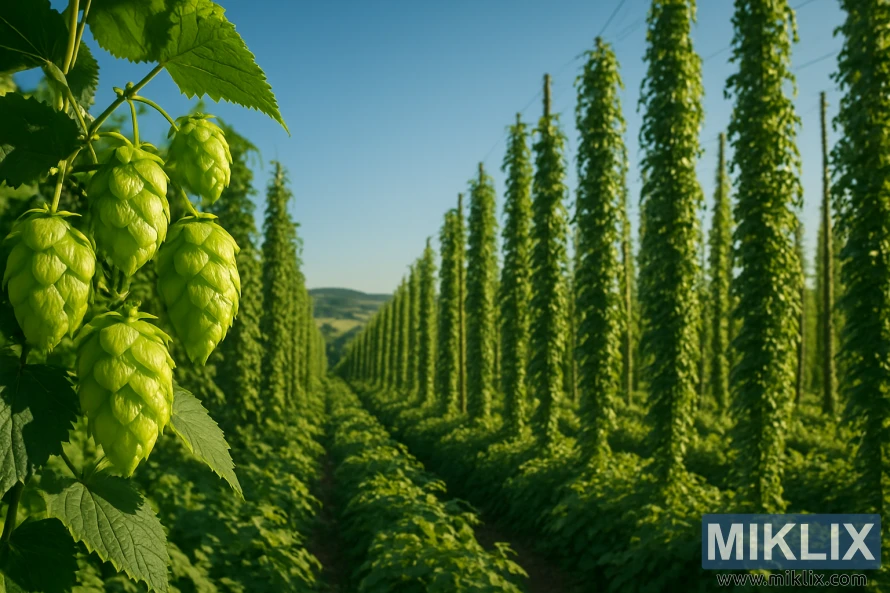
As a dual-purpose hop, Marynka excels in both early boil additions for bitterness and later additions for flavor and aroma. Both homebrewers and commercial breweries in the U.S. and globally use Marynka to infuse European flair into pale ales, bitters, and lagers. Availability can fluctuate, depending on the harvest year and supplier, but can be found through specialty hop vendors and general marketplaces.
In practical terms, Marynka hops offer firm but smooth bitterness and a distinct aroma that bridges classic English and continental European styles. Brewers seeking a hop that enhances malt complexity while adding herbal, earthy, and subtle citrus notes will find Marynka a reliable choice. It's ideal for recipes needing both a solid backbone and a rich scent.
Key Takeaways
- Marynka hops are a Polish hop variety (PCU 480, code MAR) developed from Brewer’s Gold.
- They serve as a dual-purpose hop for bittering and aroma/dry-hop uses.
- Flavor notes include herbal, earthy, and light citrus character.
- Widely used by homebrewers and commercial brewers, availability varies by year and supplier.
- Marynka brewing adds European-style balance to pale ales, bitters, and lagers.
Overview of Marynka Hops and Their Origins
The Marynka hop's roots are in Poland, where breeders aimed to create a versatile hop for both bittering and aroma. It carries the international code MAR and the breeder's ID PCU 480. Developed as part of Poland’s hop breeding efforts, it quickly found use in both local and export brewing.
Marynka's genetic lineage is clear. It was bred by crossing Brewer's Gold with a Yugoslavian male plant. This cross retained Brewer's Gold's clean bitterness and strong aromatic potential, making it valuable to brewers. It was officially registered in 1988, marking its entry into Polish hop history.
Initially, the variety was sought for its high alpha acids, a preference at the time for brewing efficiency. It has since become a reliable dual-purpose hop. Brewers value Marynka for its consistent bittering and pleasant floral-herbal notes, suitable for both lagers and ales.
Marynka's origin is part of a larger story in Polish hop history. This history includes extensive research at institutions like the Plant Breeding and Acclimatization Institute. Its practical benefits have made it a staple in international brewing programs.
Key aspects of Marynka's genealogy include its steady alpha acid levels, moderate oil content, and flavor profile influenced by Brewer's Gold. These characteristics make Marynka ideal for classic European lagers and craft beers seeking structured bitterness with subtle aroma.
Flavor and Aroma Profile of Marynka Hops
Marynka's flavor profile is a harmonious blend of bright citrus and earthy depth. It starts with a burst of grapefruit and lemon, followed by subtle notes of hay and tobacco. This unique combination sets it apart in the world of hops.
When used in late additions or dry hopping, Marynka's aroma transforms. It becomes intensely herbal and earthy. Brewers appreciate its piney and aniseed undertones, which enhance the character of pale ales and IPAs.
Marynka's versatility is evident in its dual-purpose strength. It can provide clean bitterness early in the boil. Later, it adds a burst of grapefruit and herbal notes, enriching the beer's flavor.
Many sensory reports highlight the presence of licorice hop notes beneath the citrus. This layering helps balance the sharp bitterness, adding depth and complexity to beers with a bitters-forward profile.
- Top descriptors: grapefruit, lemon, anise, hay
- Secondary tones: earthy, herbal, tobacco, chocolate hints
- Functional use: bittering and late-aroma additions
When crafting a recipe, it's crucial to pair Marynka with malts and yeasts that complement its citrus and licorice notes. This approach allows the hop's complex aroma to shine without overwhelming the base beer.
Chemical and Brewing Values for Marynka Hops
Marynka alpha acid shows significant year-to-year variation. Ranges reported include 7.5–12%, with an average near 9.8%. Other datasets suggest 4.0–11.5% or modern crop ranges of 6.2–8.5%. Brewers must account for harvest-driven swings when planning bittering additions.
Marynka beta acid is often reported near 10–13%, with an average of about 11.5% in some analyses. Occasionally, beta values are recorded as low as 2.7%. This variability underscores the importance of batch analysis over single-number assumptions.
- Alpha-beta ratio: common reports cluster around 1:1.
- Cohumulone: reported between 26–33%, with averages near 29.5% in several tests.
Total oil content typically ranges from 1.8–3.3 mL/100 g, with averages near 2.6 mL/100 g. Some harvests test closer to 1.7 mL/100 g. These differences impact late-boil and dry-hop decisions.
Oil breakdown varies by lab. One set of averages lists myrcene ~29.5%, humulene ~34.5%, caryophyllene ~11.5%, and farnesene ~2%. Other reports show myrcene at about 42.6% while humulene and caryophyllene measure lower. These figures should be viewed as guides, not absolutes.
- Practical brewing note: moderate to high Marynka alpha acid makes the variety useful for primary bittering.
- Marynka oils provide aromatic lift for late additions and dry hopping when oil levels are favorable.
- Test each batch for Marynka beta acid and oil composition to refine IBUs and aroma targets.
Understanding hop chemistry in Marynka is crucial. Measure hop lots where possible. Adjust formulations to match the measured Marynka alpha acid, Marynka beta acid, and Marynka oils for consistent results.
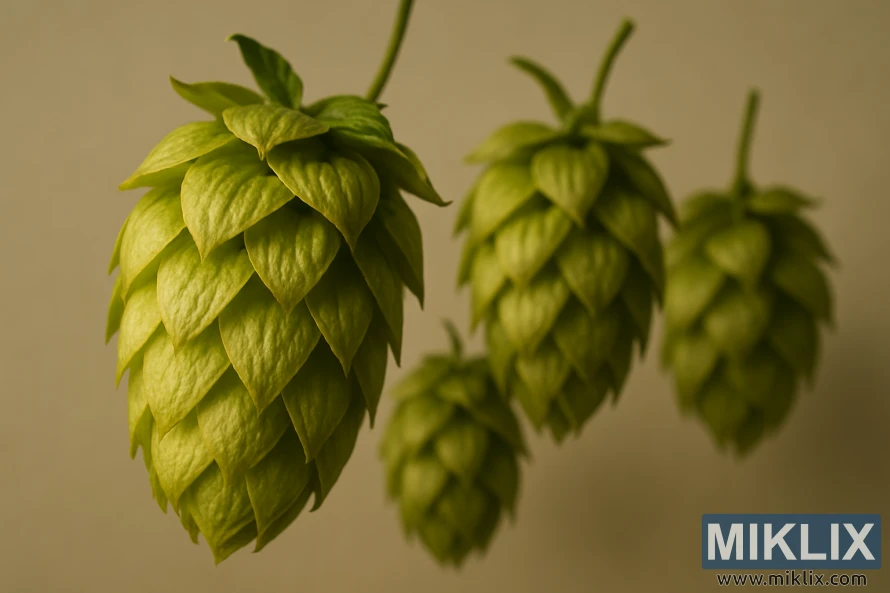
How Marynka Hops Perform in the Boil and Whirlpool
Marynka boil performance is straightforward for brewers who rely on predictable IBUs. With alpha acid values typically in the 7.5–12% range, Marynka is ideal for bittering in 60- to 90-minute additions. Long boils ensure alpha acids isomerize reliably, providing clean, measured bitterness for pale ales and lagers.
Cohumulone levels around 26–33% offer a slightly firmer bite than low cohumulone varieties. The bitterness is clean and direct, making Marynka a practical choice for clarity without harshness.
Late hot-side additions and whirlpool handling unveil Marynka's aromatic side. At lower temperatures, the hop retains citrus and herbal oil notes. Contact times of 10–30 minutes at 70–80°C extract aroma without losing volatile oils.
Total oil content, between 1.7 and 2.6 mL/100g, supports aromatic extraction in post-boil work. Brewers often blend early additions for IBUs with short whirlpool rests to capture brighter top notes from Marynka whirlpool additions.
- Boil: reliable isomerization, predictable IBU contribution.
- Bite: slightly assertive due to cohumulone, yet described as clean.
- Whirlpool: preserves citrus and herbal character when kept cool and brief.
- Use tip: combine bittering hops Marynka with late whirlpool for layered hop impact.
Marynka Hops in Dry Hopping and Aroma Contributions
Marynka dry hopping significantly enhances the aroma of beer, whether added during fermentation or conditioning. Brewers note that short contact times reveal grapefruit and citrus notes. Longer contact times, on the other hand, bring out herbal, aniseed, and earthy layers.
Practical application suggests late additions and modest dry-hop rates to emphasize aroma without increasing bitterness. Marynka hop oils are well-balanced, allowing for pronounced aroma from both whole cone and pellet forms. Despite the lack of lupulin powder from major suppliers, this balance is notable.
Expect Marynka to contribute aromas of licorice, hay, and a green herbal character. These traits are ideal for pale ales and saisons, adding complexity without a single dominant fruit note.
When planning dry-hop schedules, stagger small additions across conditioning to preserve volatile compounds. This method maximizes the benefits of Marynka dry hopping while avoiding grassy or vegetal extraction.
- Use 0.5–2.0 oz/gal for assertive aroma without harsh bitterness.
- Combine with neutral bases like Mosaic or Citra to round citrus facets.
- Short contact (3–7 days) preserves bright top notes; longer contact deepens earth and herb tones.
Marynka hop oils respond well to cool conditioning and gentle agitation. This profile enhances the integration of oil-driven aromatics into the beer. It offers a layered bouquet, perfect for both experimental small-batch and craft production.
Beer Styles That Showcase Marynka Hops
Marynka excels in both classic and modern beer styles. It's a key ingredient in Bitter, IPA, Pale Ale, and Pilsner recipes. This is due to its citrus brightness and subtle earthiness.
In hoppy ales, Marynka in IPAs provides a clean bitter backbone. It also adds a citrus-herbal top note. This works well with neutral ale yeasts and pale malt bills, ensuring the hop character is prominent.
Marynka Pale Ale benefits from a restrained malt profile. A modest amount of crystal malt is used for balance. The hop enhances citrus and licorice-like nuances, allowing malt sweetness to support the flavor.
Marynka Pilsner showcases the hop's crisp side. It's paired with pilsner malt and lager yeast. The result is a dry, refreshing lager with herbal-citrus aroma and firm bitterness.
- Traditional European lagers: clean bitterness and a gentle herbal finish.
- Amber ales: malt rounds out earthier hop traits while citrus keeps the beer lively.
- Homebrew IPAs and pale ales: frequent choice for dual-purpose hopping.
Pair Marynka with clean-fermenting yeasts for lagers or neutral ale strains for ales. Malt choices range from pilsner and marzen malts to base pale malt with small additions of crystal for depth.
Homebrewers often use Marynka as a dual-purpose option. Its versatility suits both hop-forward beers and malt-driven lagers. This makes Marynka a practical choice across diverse Marynka beer styles.
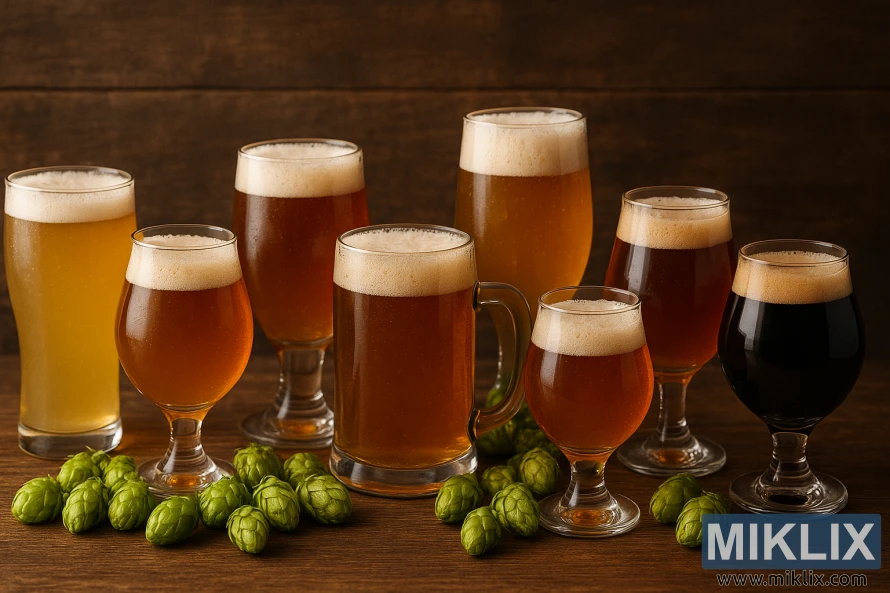
Typical Dosages and Usage Rates
Marynka dosage can vary based on several factors. These include the alpha acids, the style of beer, and the brewer's objectives. It's crucial to check the current alpha acid percentage for the crop year before calculating IBUs. Typically, alpha acid ranges are around 6.2–12%, necessitating adjustments.
Standard hop addition roles guide general Marynka usage rates. For bittering, use the measured AA% and standard utilization to achieve the desired IBUs. For late additions, whirlpool, and dry-hop, increase the mass to enhance aroma and flavor.
- Example bittering: 0.5–1.5 oz per 5 gal for moderate bitterness in many ales when AA% is midrange.
- Late/whirlpool: 0.5–2 oz per 5 gal depending on desired aroma intensity.
- Dry-hop: 1–3+ oz per 5 gal when a strong citrus and herbal lift is wanted for IPAs or Pale Ales.
Stylistic dosing is also important. In Pale Ale and IPA, moderate to heavy late, whirlpool, and dry additions are recommended. This highlights citrus and herbal notes. For Pilsner or English Bitter, keep late additions low. This preserves a clean bitter backbone and subtle floral character.
Brewers should track Marynka hopping rates by logging alpha acid tests each season. One analytics source provides dosage per style and usage across many recipes. Remember, grams or ounces must be scaled to your AA% and batch size.
- Measure AA% from your supplier or lab.
- Calculate bittering additions to reach target IBUs.
- Adjust late/whirlpool and dry-hop mass to achieve the desired aroma, using the ranges above as a starting point.
Keep records of Marynka dosage and usage rates for each batch. Tracking helps refine hopping decisions over time. It ensures consistency when alpha acids shift between harvests.
Common Substitutes and Pairings for Marynka Hops
When Marynka is hard to source, brewers often reach for a Tettnanger substitute. Tettnanger matches Marynka’s noble-like spice, mild citrus, and gentle herbal tones. Use it for late additions or dry hopping when you want a close aromatic stand-in.
For hop pairings Marynka works well with both European and New World varieties. Pair Marynka with Lubelska pairing to deepen Polish hop character and add soft floral notes. That match keeps the beer grounded in classic Polish aroma while adding complexity.
Consider layering hops for contrast. Combine Marynka with citrus-forward American varieties to create a hybrid profile that highlights citrus top notes over an herbal base. Use a light touch so the noble qualities remain distinct.
- Substitute option: Tettnanger substitute for late-boil and aroma layers.
- Local pairing: Lubelska pairing to reinforce Polish floral and spice traits.
- Hybrid approach: blend with citrus-forward hops for modern pale ales and IPAs.
Recipe design tips favor balance. Start with 60–70% Marynka character or its substitute, then add 30–40% of a complementary hop to avoid masking the hop’s subtle spice. Adjust rates based on alpha acids and the target aroma profile.
In experimental batches, document sensory changes when swapping Marynka substitutes or trying new hop pairings Marynka. Small-scale tests reveal whether a Tettnanger substitute keeps the intended noble backbone or shifts the beer toward brighter citrus. Use those notes to refine larger brews.
Marynka Hops Availability and Purchasing Tips
Marynka availability varies across the United States and Europe. You can buy Marynka hops from regional wholesalers and online retailers that list crop details. Check listings for package size and price before you commit.
Many Marynka suppliers post alpha acid tests and oil breakdowns with each lot. Inspect the Marynka harvest year on the product page. Hops from different harvest years can show clear shifts in AA, beta acids, and essential oils.
Typical formats include whole leaf cones and pellets. Major lupulin processors such as Yakima Chief, BarthHaas, and Hopsteiner do not offer Cryo or lupulin concentrates for Marynka at scale yet. If your recipe needs lupulin products, plan substitutions or scale pellet additions instead.
- Request an up-to-date COA when you buy Marynka hops to confirm alpha and oil figures for brewing to target IBUs.
- Compare prices across Marynka suppliers and factor in shipping for refrigerated or quick-turn orders.
- If a specific Marynka harvest year is required, lock orders early; small lots can sell out fast in peak season.
When buying, prioritize suppliers that offer traceable COAs and clear harvest year labeling. That practice limits batch surprises and keeps bitterness and aroma closer to your brew schedule.
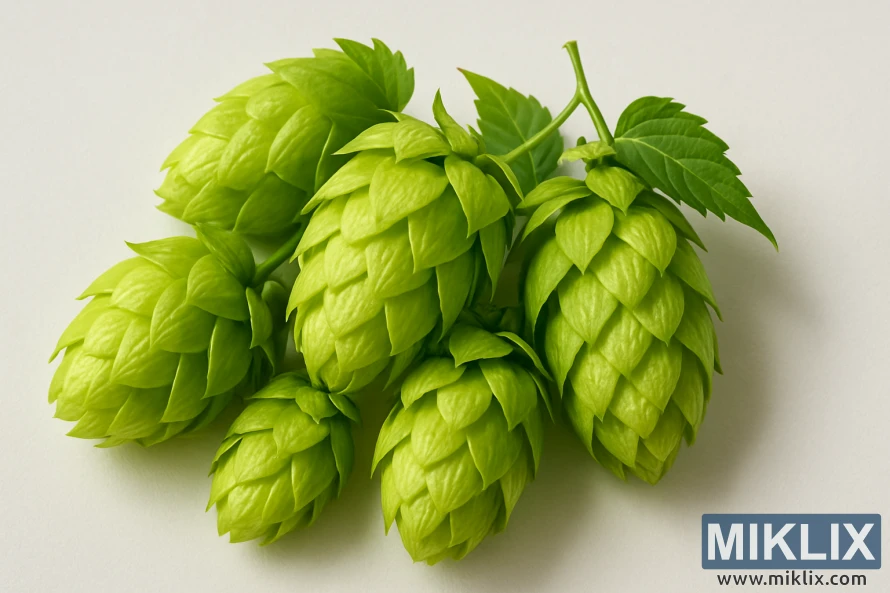
Marynka Hops Processing Forms and Limitations
Marynka hops are mainly available as whole cones and pellets. Whole cones are ideal for brewers who value minimal processing. They offer unique flavor extraction but require careful handling of trub and filtration.
Pellets, on the other hand, are the preferred choice for both homebrewers and commercial brewers. They provide consistent utilization and are easy to store. Pellets break down during the brewing process, often leading to higher extraction rates than cones.
The availability of concentrated lupulin products is a significant limitation. Major players like Yakima Chief Hops, BarthHaas, and Hopsteiner do not offer Marynka lupulin in Cryo, LupuLN2, or Lupomax formats. This scarcity limits the options for those seeking lupulin-only aroma extraction and ultra-clean dry-hop additions.
When selecting a form, consider your equipment and clarity goals. Pellets can clog pumps and filters if not managed properly. Whole cones, on the other hand, introduce vegetal matter that may require longer contact times for aroma release. Adjust your dry-hop contact time and trub handling based on the form you choose.
- Use Marynka pellet hops for consistent IBUs and efficient aroma pickup.
- Choose Marynka whole cones when minimal processing is preferred and filtration capacity is strong.
- Plan around limited Marynka lupulin availability if you want concentrated lupulin character.
Match your form to your process: breweries with advanced equipment like plate filters and tight transfer systems often prefer pellets. Smaller breweries and brewpubs that can manage whole-leaf handling may choose cones to preserve traditional hop character.
Recipe Examples and Real-World Uses of Marynka
Marynka is a staple in craft and homebrew recipes. It's often used in bittering roles for pilsners and European bitters. In pale ales and IPAs, it's added late or used for dry-hop to introduce herbal and citrus notes.
Practical recipes often combine Marynka with Lubelska or Tettnanger to achieve classic continental profiles. It's chosen for its clean bitterness, adding a subtle spice and floral lift. This supports malt-forward backbones without overpowering them.
Below are common real-world uses seen in recipe collections and competitions.
- European Bitter: 2–4 g/L at boil for balanced, clean bitterness.
- Pilsner: early boil additions with 4–6 g/L when higher AA% is adjusted.
- Pale Ale/IPA: 5–10 g/L split between late kettle and dry-hop for herbal-citrus aroma.
- Blended Aromas: small amounts combined with Saaz or Hallertau for complexity.
Marynka homebrew examples often include adjustments for current alpha acids. This is due to year-to-year AA% swings. Authors frequently note to adjust based on current AA% or include lab-tested values for IBU accuracy.
When crafting a recipe, start with conservative bittering numbers. Scale late additions to taste. This approach showcases Marynka's layered aroma while maintaining a clean bitterness for crisp finishes.
Recipe prevalence shows Marynka's practical adoption. It supports both traditional European beers and modern hoppy styles. Homebrewers and craft brewers find these recipes useful templates to adapt to local malts and water profiles.
How Marynka Hops Influence Final Beer Mouthfeel and Bitterness
Marynka bitterness emerges early in the boil, presenting a clean, sharp edge. Brewers note its quick onset and a finish that rarely lingers. This characteristic helps beers remain crisp and easy to drink.
The cohumulone levels in Marynka, typically in the mid range, impart a slightly sharper bite. Sensory panels, though, prefer the overall clarity of bitterness over any harshness. This is when hops are used thoughtfully.
Marynka's mouthfeel is influenced by its oil profile and aroma mix. Citrus and herbal notes contribute to a dry, brisk finish. This balances the malt sweetness in pale ales and lagers.
- Use Marynka for a firm bitter backbone without heavy lingering astringency.
- Pair with lower-cohumulone hops to soften perceived bite if a rounder finish is desired.
- Favor late hopping for aroma lift when you want more Marynka mouthfeel influence than hot-side bitterness.
When crafting recipes, use modest bittering additions and increase late additions. This approach emphasizes aroma and mouthfeel while controlling Marynka bitterness. Adjustments to hop timing and blend ratios can lead to a smoother drinking experience.
In practice, brewers balance co-pitched hops and late hops to fine-tune cohumulone Marynka contributions. Small changes in hop schedule can transform a beer from brisk and assertive to soft and aromatic. This is done without losing the characteristic Marynka clarity.
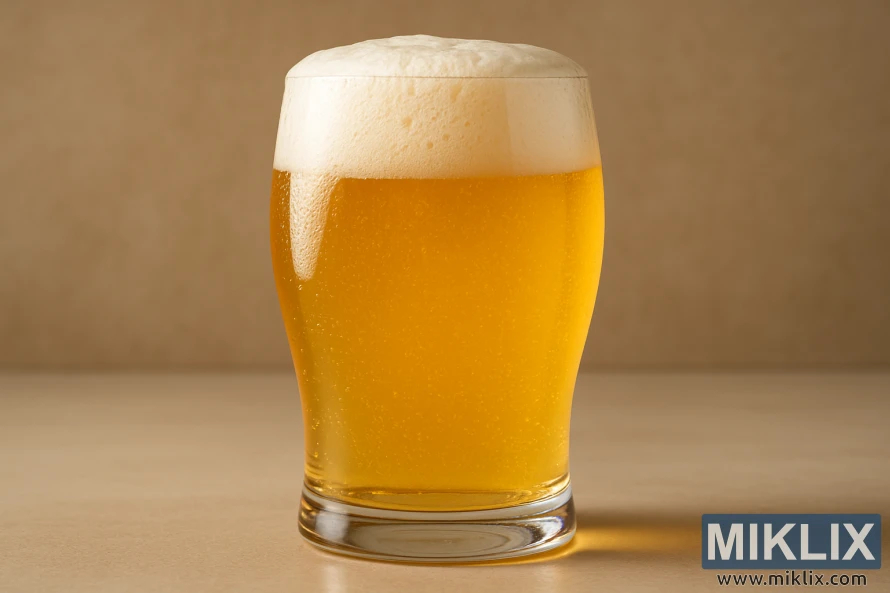
Storage, Freshness, and Hop Quality Considerations
Fresh hops significantly enhance aroma and bitterness. Before purchasing, verify the Marynka COA for alpha acids, beta acids, and total oils. This ensures the specific harvest year's characteristics match your recipe, mitigating crop-to-crop variability.
Proper storage of Marynka is crucial. Use vacuum-sealed bags to minimize oxygen exposure. Store pellets or cones at 0°F (-18°C) if possible. If a freezer is unavailable, refrigerate in airtight containers, aiming to maintain a consistent temperature to slow oil degradation.
Pelleted Marynka generally retains brewing characteristics longer than whole cones, provided they are stored correctly. The compact nature of lupulin in pellets protects oils and acids. For late-addition aroma, inspect the hop freshness Marynka closely, as volatile oils degrade rapidly, affecting the final aroma.
Request or compare supplier lab reports for consistent quality control. A current Marynka COA will detail alpha acid percentage, oil content, and harvest date. These figures are essential for calculating sample brews and substituting hops to maintain bitterness and flavor consistency.
- Store sealed in oxygen-barrier packaging.
- Freeze at 0°F (-18°C) for long-term preservation.
- Label packages with harvest year and COA reference.
- Use older stock for bittering additions; save freshest for late or dry hop.
Simple sensory checks can identify degraded lots. If Marynka hops smell muted, musty, or cardboard-like, they are likely less fresh. Trust the COA and your nose when evaluating replacements or dosing adjustments.
Marynka Hops in Commercial Brewing and Industry Context
Marynka commercial brewing is a staple in the regional and export-focused brewery scene. It brings a clean bitterness and a versatile profile, ideal for lagers, pale ales, and hybrid beers. These beers benefit from its herbal, earthy, and bright citrus notes.
The Polish hops industry is home to small to medium growers, providing fresh leaf and pellet hops. Breweries that work with Marynka often prefer direct connections with Polish cooperatives. This allows them to track harvest changes and ensure consistent alpha acid levels.
In the Marynka market, this hop remains a niche choice compared to New World varieties. Craft and macro brewers opt for Marynka for its classic European hop character. They prefer its balance over the intense fruity flavors found in other hops.
Product development for Marynka is hindered by the absence of Cryo or lupulin-concentrate options from major processors. This includes Yakima Chief, BarthHaas, and John I. Haas. This limitation affects large-scale programs that rely on concentrated formats for inventory management.
- Monitor harvest-year variability and request certificates of analysis to control batch-to-batch flavor.
- Consider forward contracts or forward-buy programs to lock in quality and tonnage for seasonal releases.
- Test small pilot batches before rolling Marynka into core recipes to verify oil and bitterness impact.
Brewers should consider the supply chain when adding Marynka to their production lines. Sourcing from the Polish hops industry and ensuring supplier transparency is key. This helps maintain consistency across batches and markets.
The Marynka market values subtle herbal-earthy complexity. For commercial brewers looking for a reliable European hop with regional roots, Marynka is a practical choice. It offers clear sourcing and flavor benefits.
Conclusion
Marynka summary: This Polish dual-purpose hop is a reliable choice for brewers. It provides a solid bittering backbone and offers herbal-citrus aromatics. Its heritage from Brewer’s Gold and registration in 1988 contributes to its unique flavor profile. This includes notes of grapefruit, lemon, aniseed, licorice, hay, and earthy undertones.
Its balanced characteristics make Polish Marynka hops suitable for a variety of beer styles. These include Bitter, IPA, Pale Ale, and Pilsner recipes. The hop's versatility is a key benefit for brewers looking to enhance their brews.
Alpha acids and oil totals can vary by crop year. Always refer to the current Certificate of Analysis (COA) when calculating IBUs. In practice, Marynka excels in early boil additions for clean bitterness. It also shines in late whirlpool hops for rounded flavor and dry-hopping to highlight citrus and herbal tones.
When Marynka is not available, Tettnanger can be a suitable substitute. Pairing it with Lubelska adds an extra layer of Polish character to your brew. For purchasing and storage, choose pellets or whole cones based on your preference. Always buy using harvest-year lab values.
Store your Marynka hops vacuum-sealed and frozen or refrigerated. This method helps preserve the oils and acids. In conclusion, Marynka hops offer a versatile and characterful option for brewers. They provide a European, herbal-citrus profile with dependable bittering performance.
Further Reading
If you enjoyed this post, you may also like these suggestions:
- Hops in Beer Brewing: Southern Cross
- Hops in Beer Brewing: Shinshuwase
- Hops in Beer Brewing: Tettnanger
